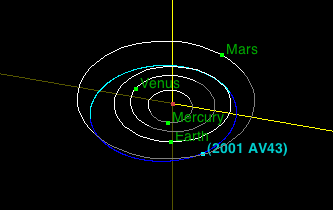Asteroid to make ‘close’ pass to Earth on Monday

Astronomers are hoping to get a close look at an asteroid Monday as it makes a relatively close pass to Earth.
The space rock, known as 2001 AV43, will approach within 650,000 miles, or 2.7 times the distance from the Earth to the moon. That is considered an eyelash width in cosmic terms.
The rapidly spinning asteroid, discovered on Jan. 5, 2001, by MIT’s Lincoln Laboratory, is flying by at a relative velocity of 8,000 mph and has an estimated diameter of between 100 and 230 feet.
That makes it about the same size as the rock that created mile-wide, 550-feet deep Meteor Crater in Arizona about 50,000 years ago. That one was 165 feet in diameter and exploded with the equivalent force of 10 megatons of TNT.
The angle of approach of 2001 AV43 makes it a good radar target for the Goldstone Deep Space Network in California’s Mojave Desert and the Arecibo Observatory in Puerto Rico, scientists say.
Meanwhile, astronomers using observatories in Hawaii are gathering information on two recently discovered and surprisingly large near-Earth asteroids.
Don't miss out on what's happening!
Stay in touch with breaking news, as it happens, conveniently in your email inbox. It's FREE!
A third object, initially thought to be an asteroid, has turned out to be a long-period comet after observations from the Canada-France-Hawaii telescope on Mauna Kea.
The discoveries were reported Nov. 5 by Don Yeomans and Paul Chodas of the Near-Earth Object Program Office, run by NASA’s Jet Propulsion Laboratory.
The first, named 2013 UD4, was spotted Oct. 23 from Arizona when it was 270 million miles from Earth. Its diameter of 12 miles was confirmed by MIT researchers Oct. 31 using NASA’s Infrared Telescope Facility on Mauna Kea.
“Not only is this object unusually large, it follows a very unusual highly inclined, retrograde orbit about the Sun, which means it travels around the Sun in the opposite direction of all the planets and the vast majority of asteroids,” the NASA scientists reported.
The second, 2013 UP8, found Oct. 25 by the Pan-STARRS group on Haleakala, has an orbit that brings it within 3.4 million miles of Earth, placing it in the top 5 percent of “potentially hazardous” asteroids, the scientists said. There is no short-term threat, they emphasized.
The third new “asteroid,” 2013 US10, discovered Oct. 31, initially was estimated to have a 12-mile diameter. But new data from Canada-France-Hawaii now indicate it’s a comet, so it got a new name, C/2013 US10 (Catalina), and its diameter is being reassessed.





